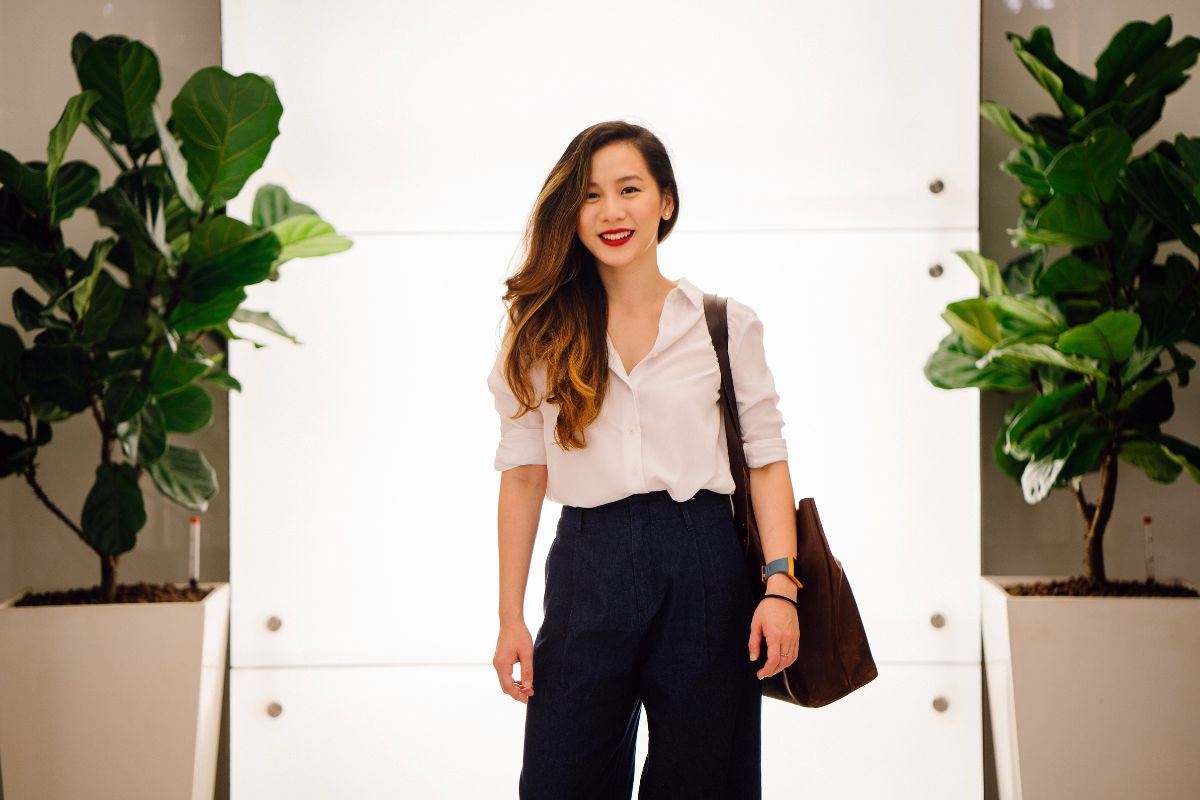Stay Cool and Confident with These Summer Office Wear Tips

Dressing for the office in hot weather is a perennial challenge. A sweaty commute and frigid air conditioning often collide with the need to look polished. As Vogue notes, summer office life means “a sweaty commute, frigid air conditioning, and… sitting for most of the day,” so the goal is a balance between fashion-forward and perfectly professional”. Etiquette experts similarly warn that while summertime feels relaxed, “the formality of office attire can often diminish… [but] appearances are always important”. In other words, even when it’s hot, your outfit should look deliberate and respectful of the office dress code. The trick is to choose lightweight, breathable pieces and thoughtful layering so you stay cool without sacrificing a sharp, work-appropriate look.
Perfect Fabrics for Summer Workwear
Natural fibres dominate summer wardrobes because they breathe and wick moisture. Linen is ideal: its fibre structure absorbs moisture quickly and conducts it away, allowing fabric to breathe and not cling. Cotton is also a top choice – it feels soft and cool, though it can hold onto dampness a bit longer than linen. Consider fabrics like chambray or cotton blends as well; they are lightweight and allow air flow. Many clothing experts recommend unlined or half-lined jackets and trousers in warm months, since linings trap heat. For example, a half-lined blazer in a tropical wool or linen blend lets air circulate much better than a fully lined suit. Even some fine lightweight wools (“tropical wool”) and wool-silk blends can be surprisingly cool for summer suiting.
- Linen and Linen Blends: Extremely breathable and moisture-wicking. (Be aware linen wrinkles easily.)
Cotton: Soft and cool; look for poplin or seersucker. Cotton jersey or knit polos also breathe well. - Breathable Blends: Cotton-linen blends or lightweight wool blends (especially unlined) work well. Chambray is an excellent shirt or trouser fabric.
- Moisture-Wicking Synthetics: Modern performance fabrics (like Dri‑FIT or technical blends) can be used in shirts or undershirts to draw sweat away, though purely synthetic fabrics like polyester generally feel clammy if unmodified.
- Light Colours: Fabrics in white, beige, soft pastels, and neutrals reflect heat and look crisp. Avoid heavy, dark colours, which absorb sunlight.
Choosing the right fabric is step one to staying comfortable: “lightweight and breathable fabrics”, such as cotton and linen, allow air circulation and keep you cool and comfortable on the hottest days.
Style Tips for Men and Women
Layer Wisely: Even in summer, a bit of layering can add polish and flexibility. Start with a solid, opaque base layer (e.g. a white cotton tee or sleeveless shell) and layer a sheer shirt or lightweight jacket over it. For example, a crisp white tee under a very light linen shirt or blazer creates a clean base that still circulates air. Tailored layers can be removed in very hot moments or when outdoors. For women, a sleeveless vest or tailored waistcoat is an excellent warm-weather suiting strategy – it gives the look of a blazer without trapping heat in the arms.
Start with a lightweight opaque base layer (like this white cotton tee) and layer a sheer or light jacket on top for style. Stylist Chernyaev suggests “opaque fabrics in tank tops or tees” under a “lightweight sheer shirt or sweater” to stay cool yet put-together.
Fit and Silhouette: Looser fits breathe better than tight clothes. Form-fitting garments trap heat next to the skin, whereas a relaxed fit allows airflow. Experts advise choosing clothing that “fits comfortably but isn’t too tight to allow air to flow through”. For both genders, slightly unstructured or “roomy” pieces can feel more comfortable. For example, women might choose an A-line or fit-and-flare dress (with a looser skirt) rather than a pencil sheath. Men can try unconstructed sport coats or half-lined blazers: these have minimal padding and linings, so they don’t stick to your body.
Colour and Pattern: Light, bright colours and subtle patterns are most suitable. Whites, creams, pastels, and light blues help reflect the sun’s rays and visually cool off your look. A pop of colour (coral, turquoise, lemon yellow) can add personality and even help reflect heat. Avoid overly bold or neon prints that may look too casual; simple stripes or polka-dots are safer for work. As one style director notes, pastel or neutral polos are an “essential” summer piece – these can be paired with solid shorts or pants for a crisp office-casual look.
Men’s Style: Key pieces include unconstructed blazers and half-lined jackets in cotton-linen or breathable blends. A half-lined or unlined blazer cuts down on bulk so you stay cool, but still looks sharp when buttoned. Pair blazers with light cotton shirts (or knit polos) and chinos or lightweight dress pants. In very casual offices, an open-collar linen shirt alone can work, or a short-sleeve button-down (camp collar) in cotton. Rolling up your sleeves and unbuttoning the top button are fine if your office allows a more relaxed look. Shoes: Leather loafers or dressy boat shoes keep things polished. In a casual setting, a clean, minimal sneaker (e.g. leather tennis shoe) can be acceptable. Always avoid athletic sneakers that look too sporty.
Women’s Style: Summer-friendly pieces include breathable dresses, skirts or pant suits in lightweight fabrics, and blouses. An A-line or fit-flare cotton/linen dress is both cooling and office-appropriate. If wearing separates, choose a knee-length or midi skirt (not a micro-mini) and pair it with a silk or cotton blouse. Sleeveless dresses or tops are OK if paired with a light blazer or cardigan for meetings. Short-sleeve blouses with subtle collars and cap sleeves are also office-appropriate. Women can also try the trendy “short suit”: tailored linen shorts with a matching blazer (in white or tan), paired with a blouse or shell underneath. This modern set looks chic yet keeps you cooler than a long pantsuit. Complete these looks with simple jewellery: a delicate necklace or bracelet adds polish without bulk.
A light-colored, linen-blend blazer (like this Stella McCartney jacket) adds professional structure without overheating. Vogue’s advice: pair a linen or cotton blazer with matching pieces (skirt or trousers) for a crisp summer suit.
Outfit Ideas by Dress Code
Business Formal: For men, a light wool or linen suit (jacket and trousers) in a neutral shade (grey, navy, or tan) is ideal. Pair it with a breathable cotton dress shirt; you may skip the tie or wear a silk knit tie in light colours. Brown or black leather Oxfords or loafers are classic. For women, a coordinating suit (either a pantsuit or skirt suit) in a summer-friendly fabric works well. Under a blazer, you might wear a crisp blouse or sleeveless shell. A tailored vest (waistcoat) set is another formal option. Choose closed-toe pumps or flats. Example: a pale beige linen-blend skirt suit with a white cotton blouse and nude leather loafers, or a grey unlined pant suit with a silky pastel top and kitten-heel slingbacks.
Business Casual: This is less formal but still neat. Men can wear chinos or lightweight dress pants with a short-sleeve button-up or knit polo. Adding an unstructured blazer or vest can dress it up if needed. Women might choose a midi-length skirt or ankle pants with a pretty blouse or knit top. Summer dresses (fabric that holds shape) can work too. On casual Fridays, one outfit idea is white jeans with a patterned blouse for women (e.g. white denim + printed cotton top). Footwear here can be a notch more relaxed: loafers, block-heeled sandals (closed or peep-toe), or polished flats.
Smart Casual: This allows more personal style. Men could wear dark denim or chinos with a linen or cotton shirt (short or long sleeve) and casual loafers or clean sneakers. Women might do dark jeans or culottes with a dressy top, or a casual summer dress with a light cardigan. Leather or suede loafers (with or without a small heel) are versatile. Even an espadrille or leather sandal with a block heel can be okay if it looks refined. Use this category to showcase personality with accessories, as long as the overall look stays tidy.
Footwear Suggestions
Choosing the right shoes is key for both comfort and style. Loafers are a fail-safe choice – they work for men and women and keep a professional look. In fact, Cosmopolitan notes “Loafers are a sure winner when it comes to office footwear,” and a bold patterned or slingback loafer adds flair to a summer outfit. For women, ballet flats or pointed-toe flats are breezy and work-ready. Kitten heels or low block heels (closed or with a slingback strap) also elevate an outfit without overheating; Vogue highlights kitten-heel slingbacks as an “office-ready pump”. Wedges can be comfortable for long days, provided they’re not too beachy. In cooler offices, closed-toe Mary-Jane flats or mules (backless flats) are stylish picks.
For men, traditional leather Oxfords, brogues, or derby shoes are still appropriate if the dress code is formal. In business-casual settings, driving moccasins, loafers, or even boat shoes are great summer alternatives. Men’s health editors emphasise that “a pair of rugged boat shoes or loafers can keep your nine-to-five look fresh” in the heat. A minimal, clean sneaker (especially in leather or breathable knit) can be acceptable if your office skews casual, but steer clear of running or athletic styles.
Avoid: Flip-flops or beach sandals of any kind. They look too casual for almost any office (even well-groomed feet in sandals can be off-putting). Also, avoid open-toe shoes for men and very casual slides. If you do wear sandals at all, make sure they’re a professional style (e.g. leather slingbacks) and that your toenails are tidy.
Do’s and Don’ts
Do:
- Follow the dress code: Always adhere to your company’s guidelines – if jackets are required, wear one; if ties are optional, feel free to go tieless in the heat. As etiquette experts advise, “If your company has a dress code, follow it… [It shows] respect for your company and its culture”.
- Choose cool fabrics: Opt for linen, cotton, and breathable blends (chambray, light wool, etc.).
- Keep it light and loose: Wear slightly looser cuts (not body-con) and stick to light colours and neutrals. Light hues and pastels “can help reflect sunlight and keep you from overheating”.
- Layer for versatility: Carry or wear a lightweight blazer, vest, or cardigan. This lets you add polish for meetings and take it off if you get too warm.
- Maintain neat grooming: If you wear sandals, keep your feet clean and nails trimmed. Ensure your clothes are pressed (wrinkles from linen are fine, but look intentional).
- Accessorise lightly: A hat or sunglasses can be wise for commuting and outdoors, but remove them indoors. Simple jewellery can brighten an outfit without adding heat; for example, a light necklace under a shirt collar adds personality.
Don’t:
- Don’t wear shorts in a professional setting: Most offices consider shorts too casual, and air conditioning is often cool enough that pants are necessary.
- Don’t wear flip-flops or gym sandals: Sandals should look polished; flip-flops (even dressy ones) and athletic slides are usually off-limits. Men should also avoid going sockless in loafers.
- Don’t reveal too much: Avoid tops that show bare midriffs, thin spaghetti straps, strapless or see-through fabrics. As one etiquette guide puts it, the fabric and cut should say “professional,” not “beach day.” (Wide tank top straps and sleeveless styles are safer if truly needed.)
- Don’t neglect comfort for style: Skip excessively high stilettos or stiff collars that will make you sweat. If an outfit will make you fidget or sweat all day, it’s better to find a cooler alternative.
By following these guidelines—choosing airy fabrics, light colours, relaxed fits, and smart layering—you can beat the heat without compromising professionalism. In sum, plan your wardrobe with function in mind, and you’ll arrive looking crisp and confident even on the hottest days.
Conclusion
Dressing for the office during summer doesn’t have to mean sacrificing style or comfort. By choosing lightweight, breathable fabrics like linen, cotton, and tropical wool, and prioritising fit, colour, and appropriate layering, you can maintain a polished and professional look even in soaring temperatures. Whether your office leans formal or casual, there are plenty of warm-weather outfit options that balance elegance with ease. The key is to stay cool—both in body and in style—while respecting the workplace environment. With the right choices, your summer office wardrobe can be just as sharp and confident as the rest of your year-round attire.






